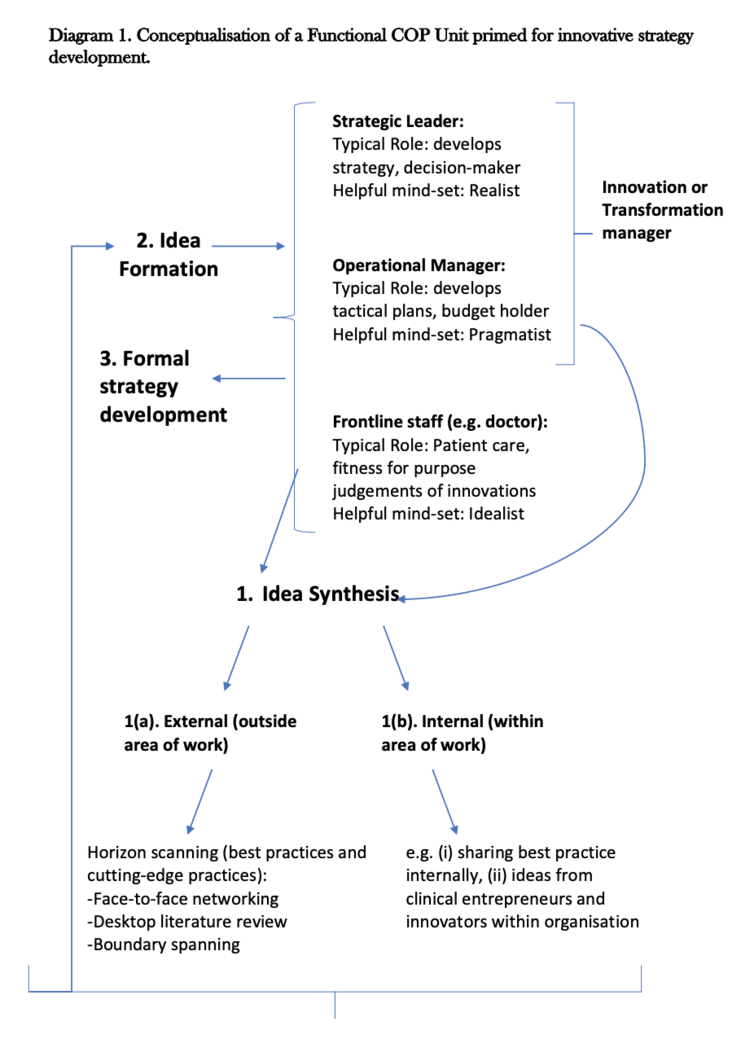Frontline clinical staff need to be effective followers to support strategic leaders and play a key role in nurturing a culture of innovation. One profound way of grounding such a culture in practice is through the formation of a special kind of Community of Practice (COP) primed for innovative thinking.
COPs unite groups to informally deliberate a shared interest, with a view to generate new knowledge (1). This new knowledge has multiple uses, from informing strategy to being disseminated as best practice (1).
COPs Primed for Innovation
The conceptualisation of a COP primed for Innovation (which I refer to as a ‘Functional COP unit’) is illustrated below:

This has a number of novel characteristics.
Aspiring for functionality
The Functional COP aspires to unite four key players: the group required to be consulted and informed (frontline staff), the group having formal responsibility for overseeing innovation (i.e. innovation/transformation managers), the ultimate decision-makers (strategic leaders) and the group stewarding tactical feasibility of plans (operational managers).
‘Epistemic’ in nature
This approach somewhat resembles an ‘epistemic’ community (2) in that it unites autonomous multi-professionals, geared towards radical change (2). However, the unification of professionals is not random but aligned towards a functionality which facilitates innovative thinking and effective change management.
Shared and formal responsibilities
Idea generation is a distributed task among this COP cohort, meaning that the suspension of hierarchical dominance is foundational to the success of such a community.
Innovation/transformation managers straddle both operational and strategic realms and most likely have formal responsibility for mobilising their organisations for innovation. They may do this by engaging with entrepreneurs to share cutting edge practices and by taking responsibility for horizon scanning and boundary spanning.
Knowledge from external sources
The model draws on external sources e.g. through horizon scanning, which uses systematic approaches (e.g. literature reviews and trend analysis) to predict possible futures to inform strategy development (3). Boundary spanning i.e. cross boundary-working (4) to gain insights in to other industries (e.g. emergent technologies), organisations and analogous departments (e.g. service improvements) can help deliver creative solutions not achievable through lone working.
(The Academy of Fabulous Stuff is an excellent resource for horizon scanning and boundary spanning).
In Conclusion
In essence, this COP is a dress rehearsal, informing formal strategy development and providing prescient insights in to perceptions of nascent innovations.
Bringing clinical entrepreneurs and innovators to the fore of organisational contemporary thought in this way utilises the knowledge economy from within, which may otherwise burst at the organisational seams and fizzle out or lie dormant until presented with appropriate channels of engagement.
Inclusive cultures permit creation of such COPs, garnering contributions organisation-wide and instilling shared ownership for change. Such cultures unleash the potential of frontline clinicians, entrepreneurs and innovators to influence those formally accountable for developing strategy.
You can find the references here
(Note: a full-length version of the article can be read on the PM Times website at the following link:
